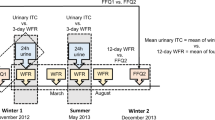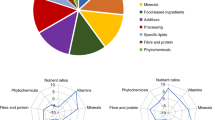Abstract
Objective: To develop a food frequency questionnaire for adolescents (AFFQ) and demonstrate its relative validity.
Design: The final version of the AFFQ was composed of 76 food items previously identified according to their contribution in nutrients and overall importance within the eating habits of this population group. The validation study, which was undertaken during a 6 month period (June to November 1999), was administered to a sample of 79 who answered at least three 24 h dietary recalls (R24 h) applied at intervals of 45 days and one AFFQ at the end of the study. Applying the paired t-test and calculating Pearson correlation coefficients on nutrient data, differences in the mean of nutrients were obtained. Correlation coefficients between the mean energy-adjusted nutrients computed by the two methods were calculated, and correction was made for within-person variability. Agreement was evaluated by distribution of the adolescents according to quartiles of consumption.
Locus: A public school within the metropolitan region of São Paulo city.
Results: A high variability in the dietary intake of adolescents was observed, with high rates of variability for cholesterol, retinal and vitamin C. The Pearson correlation coefficients, after being adjusted and corrected for variability, ranged from 0.10 to 0.72 among females and from 0.16 and 0.91 among males. The mean correlation coefficient for the entire group was 0.52.
Conclusions: These results indicate that the AFFQ provides a potentially reliable scale for categorizing individuals by level of past intake of most nutrients, excluding retinol and iron.
This is a preview of subscription content, access via your institution
Access options
Subscribe to this journal
Receive 12 print issues and online access
$259.00 per year
only $21.58 per issue
Buy this article
- Purchase on Springer Link
- Instant access to full article PDF
Prices may be subject to local taxes which are calculated during checkout

Similar content being viewed by others
References
Beaton, GH, Milner, J, McGuire, V, Feather, TE & Little, JA (1983). Source of variance in 24-hour dietary recall data: implications for nutrition study design and interpretation. Carbohydrate sources, vitamins, and minerals. Am. J. Clin. Nutr., 37, 986–995.
Block, G, Dresser, CM, Hartman, AM & Carroll, MD (1985a). Nutrient sources in the American diet: quantitative data from the nhanes II survey. I. Vitamins and minerals. Am. J. Epidemiol., 122, 13–26.
Block, G, Dresser, CM, Hartman, AM & Carroll, MD (1985b). Nutrient sources in the American diet: quantitative data from the nhanes II survey. II. Macronutrients and fats. Am. J. Epidemiol., 122, 27–40.
Cardoso, MA, Kida, AA, Tomita, RD & Stocco, RD (2001a). Reproducibility and validity of a food frequency questionnaire among women of Japanese ancestry living in Brazil. Nutr. Res., 21, 725–733.
Field, AE, Peterson, KE, Gortmaker, SL, Cheung, L, Rockett, H & Fox, MK et al (1999). Reproducibility and validity of a food frequency questionnaire among fourth to seventh grade inner-city school children: implications of age and day-to-day variation in dietary intake. Publ. Health Nutr., [on line]2, (3) Available from: http://saturn.bids.ac.uk (accessed 2 January 2001)
Fisberg, M, Bandeira, CRS, Bonilha, EA, Halpern, G & Hirschbruch, MD (2000). Hábitos alimentares na adolescência. Pediatr. Mod., 36, 724–723.
Flegal, K (1999). Evaluating epidemiologic evidence of the effects of food and nutrient exposures. Am. J. Clin. Nutr., 69, (Suppl) 139S–144S.
Flegal, KM & Laarkin, FA (1990). Partitioning macronutrient intake estimates from a food frequency questionnaire. Am. J. Epidemiol., 131, 1046–1050.
Friis, S, Kruger Kjaer, S, Stripp, C & Overvad, K (1997). Reproducibility and relative validity of a self- administered semiquantitative food questionnaire applied to younger women. J. Clin. Epidemiol., 50, 303–311.
Gnardellis, C, Trichopouluu, A, Katsouyanni, K, Polychronopoulos, E, Rimm, EB & Trichopoulos, D (1994). Reproducibility and validity of an extensive semi-quantitative food frequency questionnaire among teachers. Epidemiology, 6, 74–77.
Goran, MJ (1998). Measurement issues related to studies of childhood obesity: assessment of body composition, body fat distribution, physical activity, and food intake. Pediatrics, 101, (Suppl) S505–S518.
Harbottle, L & Duggan, MB (1994). Daily variation in food and nutrient intakes of Asian children in Sheffield. Eur. J. Clin. Nutr., 48, 66–70.
Jiménez, LG & Martín-Moreno, JM (1995). Cuestionario de frecuencia de consumo alimentario. In:Nutrición y Salud Pública—Métodos, bases científicas y aplicaciones, ed. LlS Majem, BJ Aranceta, MJ Verdú, pp120–125, España: MASSON
Ludwig, DS, Peterson, KE & Gortmaker, SL (2001). Relation between consumption of sugar-sweetened drinks and childhood obesity: a prospective, observational analysis. Lancet, 357, 505–508.
Martín-Moreno, JM, Boyle, P, Gorgojo, L, Maisonneuve, P, Fernandez-Rodriguez, JC, Salvini, S & Willett, WC (1993). Development and validation of a food frequency questionnaire in Spain. Int. J. Epidemiol., 22, 512–519.
Munger, RG, Folsom, AR, Kushi, LH, Kaye, SA & Sellers, TA (1992). Dietary assessment of older Iowa women with a food frequency questionnaire: nutrient intake, reproducibility and comparison with 24-hour dietary recal intrerviews. Am. J. Epidemiol., 136, 192–200.
Nelson, M (1997). The validation of dietary assessment. In:Design concepts in nutrition epidemiology, 2nd edn. B Margetts & M Nelson, pp241–272, Oxford: Oxford University Press
Nuzzo, L (1998). Avaliação do estado nutricional de adolescentes de uma instituição particular de ensino, São Paulo: Tese de Mestrado, Faculdade de Saúde Pública da USP
Ocké, MC, Bueno-de-Mesquita, HB, Goddijn, HE, Jansen, A, Pols, MA, Staveren, WAV & Kromhout, D (1997). The Dutch EPIC food frequency questionaire. I. Description of the questionnaire, and relative validity and reproducibility for food groups. Int. J. Epidemiol., 26, (Suppl. 1) 37S–48S.
Overvad, K, Tjonneland, A, Haraldsdottir, J, Ewerte, M & Jensen, OM (1991). Development of semiquantitave food frequency questionnaire to assess food, energy and nutrient intake in Denmark. Int. J. Epidemiol., 20, 900–905.
Philippi, ST, Szarfarc, SC & Latterza, AR (1996). Virtual Nutri, (software), Version 1.0 for Windows São Paulo: Departamento de Nutrição, Faculdade de Saúde Pública, Universidade de São Paulo
Rimm, EB, Giovannucci, EL, Stampfer, MJ, Colditz, GA, Litin, LB & Willett, WC (1992). Reproducibility and validity of an expanded self-administered semi-quantitative food frequency questionnaire among male health professionals. Am. J. Epidemiol., 135, 1114–1126.
Rockett, RH & Colditz, GA (1997). Assessing diets of children and adolescents. Am. J. Clin. Nutr., 65, (Suppl) 1116S–1122S.
Rockett, HRH, Breitenbach, M, Frazier, AL, Witschi, J, Wolf, AM & Field, AE et al (1997). Validation of a youth/adolescent food frequency questionnaire. Prev. Med., 26, 808–816.
Sempos, CT, Johnson, NE, Smith, EL & Gilligan, C (1985). Effects of intraindividual and interindividual variation in repeated dietary records. Am. J. Epidemiol., 121, 120–130.
Thompson, FE & Byers, T (1994). Dietary assessment resource manual. J. Nutr., 124, (Suppl 11)
Tsubono, Y, Fahey, MT, Takahashi, T, Iwase, Y, Iitoi, Y, Akabane, M & Tsugane, S (1998). Interpopulation and intrapopulation variability of nutrient intake in five regions of Japan. Eur. J. Clin. Nutr., 52, 176–179.
Willett, WC (1998). Nutritional Epidemiology, 2nd edn Oxford: Oxford University Press
Willett, WC & Stampfer, MJ (1986). Total energy intake: implications for epidemiological analyses. Am. J. Epidemiol., 124, 17–20.
Willett, WC, Sampson, L, Stampfer, MJ, Rosner, B, Bain, C & Witschi, J et al (1985). Reproducibility and validity of a semiquantitative food frequency questionnaire. Am. J. Epidemiol., 122, 51–65.
Author information
Authors and Affiliations
Contributions
Guarantor: B. Slater
Contributors: BS responsible for research design, conduction of the study and for the writing the document. STP was the advisor of the study. RMF collaborated in the interpretation and discussion of the study's results. MRDOLT collaborated in the statistical analyses and interpretation of the results.
Corresponding author
Rights and permissions
About this article
Cite this article
Slater, B., Philippi, S., Fisberg, R. et al. Validation of a semi-quantitative adolescent food frequency questionnaire applied at a public school in São Paulo, Brazil. Eur J Clin Nutr 57, 629–635 (2003). https://doi.org/10.1038/sj.ejcn.1601588
Received:
Revised:
Accepted:
Published:
Issue Date:
DOI: https://doi.org/10.1038/sj.ejcn.1601588
Keywords
This article is cited by
-
Assessing adolescent diet and physical activity behaviour, knowledge and awareness in low- and middle-income countries: a systematised review of quantitative epidemiological tools
BMC Public Health (2022)
-
Development and validation of a food frequency questionnaire (FFQ) for assessing dietary macronutrients and calcium intake in Cambodian school-aged children
Nutrition Journal (2019)
-
Excessive gain in body mass index-for-age Z-score and associated factors: a cohort study in female adolescents
European Journal of Clinical Nutrition (2017)
-
Evaluation of the relative validity of a Web-based food frequency questionnaire used to assess Soy Isoflavones and nutrient intake in adolescents
BMC Nutrition (2016)
-
Association Between Internalizing Disorders and Day-to-Day Activities of Low Energetic Expenditure
Child Psychiatry & Human Development (2015)



